
A tuna is a saltwater fish that belongs to the tribe Thunnini, a subgrouping of the Scombridae (mackerel) family. The Thunnini comprise 15 species across five genera, the sizes of which vary greatly, ranging from the bullet tuna up to the Atlantic bluefin tuna, which averages 2 m (6.6 ft) and is believed to live up to 50 years.

Burmeister's porpoise is a species of porpoise endemic to the coast of South America. It was first described by Hermann Burmeister, for whom the species is named, in 1865. Locally it is known as marsopa espinosa and chancho marino.

The yellowfin tuna is a species of tuna found in pelagic waters of tropical and subtropical oceans worldwide.

The Peruvian anchoveta is a species of fish of the anchovy family, Engraulidae, from the Southeast Pacific Ocean. It has yielded greater catches than any other single wild fish species in the world, with annual harvests varying between 3.14 and 8.32 million tonnes throughout the 2010s.

The coho salmon is a species of anadromous fish in the salmon family and one of the five Pacific salmon species. Coho salmon are also known as silver salmon or "silvers". The scientific species name is based on the Russian common name kizhuch (кижуч).
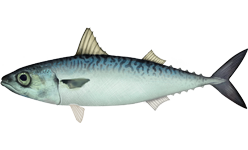
The chub mackerel, Pacific mackerel, or Pacific chub mackerel is a species of fish in the tuna and mackerel family, Scombridae. This species of mackerel closely resembles the Atlantic chub mackerel.
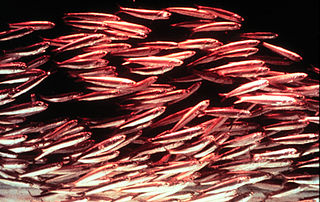
Engraulis is a genus of anchovies. It currently contains nine species.
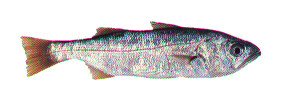
The queenfish is a species of fish in the family Sciaenidae, the drums and croakers. It is native to the eastern Pacific Ocean, where it occurs along the North American coastline from Oregon to Baja California; it has been recorded as far north as British Columbia. Its centre of distribution is the Southern California Bight. It is also known commonly as the queen croaker. This is the only species in the monotypic genus Seriphus.
The Argentine anchoita or Argentine anchovy is an anchovy of the genus Engraulis, found in and around waters of Argentina, Uruguay and southern Brazil.
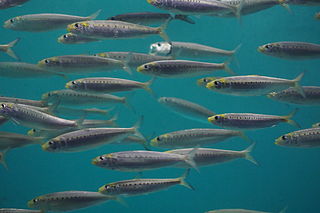
Sardinops is a monotypic genus of sardines of the family Clupeidae. The only member of the genus is Sardinops sagax. It is found in the Indo-Pacific and East Pacific oceans. Its length is up to 40 cm (16 in). It has numerous common or vernacular names, some of which more appropriately refer to subspecies, including blue pilchard, Australian pilchard, blue-bait, Californian pilchard, Peruvian Pacific sardine, South American pilchard, Chilean sardine, Japanese pilchard, Pacific sardine, and Southern African pilchard.

The California moray is a moray eel of the family Muraenidae, found in the eastern Pacific from just north of Santa Barbara to Santa Maria Bay in Baja California. They are the only species of moray eel found off California, and one of the few examples of a subtropical moray. They typically occupy boulder or cobble habitats up to 40 m in depth. They can attain lengths of about 5 ft (1.52 m) and are believed to live for upwards of 22–26 years. Like other morays, they have no pelvic or pectoral fins or gill covers.
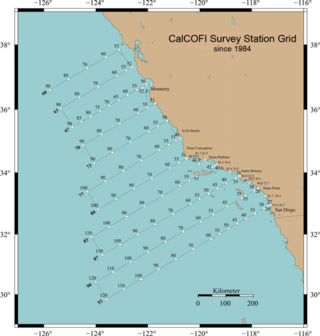
CalCOFI is a multi-agency partnership formed in 1949 to investigate the collapse of the sardine population off California. The organization's members are from NOAA Fisheries Service, Scripps Institution of Oceanography, and California Department of Fish and Wildlife. The scope of this research has evolved into the study of marine ecosystems off California and the management of its fisheries resources. In 2004, the CalCOFI survey area became one of 26 LTER research sites. This time-series of oceanographic and fisheries data allows scientists to assess the human impact and effects of climate change on the coastal ocean ecosystem. CalCOFI hydrographic & biological data, publications, and web information are distributed for use without restriction under the terms of the GNU Free Documentation License.

The Pacific bluefin tuna is a predatory species of tuna found widely in the northern Pacific Ocean, but it is migratory and also recorded as a visitor to the south Pacific.

The European anchovy is a forage fish somewhat related to the herring. It is a type of anchovy; anchovies are placed in the family Engraulidae. It lives off the coasts of Europe and Africa, including in the Mediterranean Sea, the Black Sea, and the Sea of Azov. It is fished by humans throughout much of its range.

An anchovy is a small, common forage fish of the family Engraulidae. Most species are found in marine waters, but several will enter brackish water, and some in South America are restricted to fresh water.
Sardinella brasiliensis, is a species of ray-finned fish in the genus Sardinella. S. brasilensis are extremely hard to distinguish from Sardinella aurita and are combined in most studies and catch estimates. They spawn in coastal areas during late spring and summer. The most dense spawning periods are in December and January. From 1973 to 1990 the catch in Venezuela was down from 228000 tons to 31000 tons. These fish are present in the Western Atlantic (including the Gulf of Mexico, Caribbean, West Indies all the way down to Brazil

The European pilchard is a species of ray-finned fish in the monotypic genus Sardina. The young of the species are among the many fish that are sometimes called sardines. This common species is found in the northeast Atlantic, the Mediterranean, and the Black Sea at depths of 10–100 m (33–328 ft). It reaches up to 27.5 cm (10.8 in) in length and mostly feeds on planktonic crustaceans. This schooling species is a batch spawner where each female lays 50,000–60,000 eggs.
The stable ocean hypothesis (SOH) is one of several hypotheses within larval fish ecology that attempt to explain recruitment variability. The SOH is the notion that favorable and somewhat stable physical and biological ocean conditions, such as the flow of currents and food availability, are important to the survival of young fish larvae and their future recruitment. In the presence of stable ocean conditions, concentrations of prey form in stratified ocean layers; more specifically, stable ocean conditions refer to “calm periods in upwelling ecosystems ” that cause the water column to become vertically stratified. The concept is that these strata concentrate both fish larvae and plankton, which results an increase of the fish larvae feeding because of the density-dependent increase in predator-prey interactions. Lasker is attributed with constructing this hypothesis in the late 1970s by building on previous larval fish research and conducting his own experiments. He based the SOH on case studies of clupeid population fluctuations and larval experimentation.

Anchovies are small, common saltwater forage fish in the family Engraulidae that are used as human food and fish bait. There are 144 species in 17 genera found in the Atlantic, Indian, and Pacific Oceans. Anchovies are usually classified as oily fish. They are small, green fish with blue reflections due to a silver longitudinal stripe that runs from the base of the caudal fin. They range from 2 centimetres (0.79 in) to 40 centimetres (16 in) in adult length, and the body shape is variable, with more slender fish in northern populations.
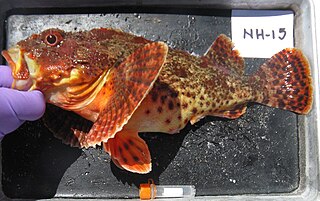
Scorpaena guttata is a species of fish in the scorpionfish family known by the common name California scorpionfish. It is native to the eastern Pacific Ocean, where it can be found along the coast of California and Baja California. Its distribution extends from around Santa Cruz, California, to Punta Abreojos in Baja California Sur, and out to Guadalupe Island. It is also found in the Gulf of California. Another common name is spotted scorpionfish.


















